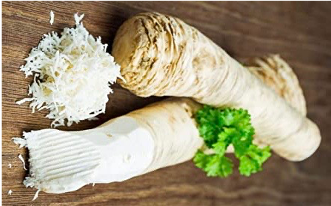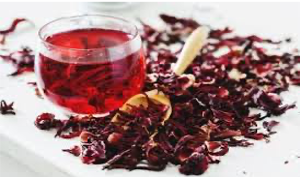Form our resident food finder Krissy Billiczky
Today’s first herb is Horseradish
 Horseradish is a white root vegetable known for its pungent taste and odour.
Horseradish is a white root vegetable known for its pungent taste and odour.
Horseradish is believed to have originated in Eastern Europe. It’s a cruciferous vegetable, alongside mustard, wasabi, cabbage, broccoli, and kale.
It has been used worldwide for thousands of years, typically as a condiment but also for medicinal purposes.
This root contains multiple compounds that may provide health benefits, including antibacterial and anticancer effects.
It has a long, white root and green leaves. When the root is cut, an enzyme breaks down a compound called Sinigrin into a mustard oil.
This oil, known as allyl isothiocyanate, gives horseradish its tell-tale odour and taste and may irritate your eyes, nose, and throat.
Scientific research is limited but it is suggested that horseradish has the following benefits:
- can help protect against cancer due to the glucosinolates and isothiocyanates in this root vegetable which help inhibit the growth of cancer cells, as well as promoting their death
- can help fight cell damage caused by free radicals due to the compound in horseradish called Sinigrin
- can help with inflammation due to high antioxidant properties
- allyl isothiocyanate, the oil released when horseradish root is cut, may have powerful antibacterial properties
- it can be used to relieve colds and breathing issues
- can help boost immune system due to high vitamin C content
Horseradish is mostly sold and enjoyed as a condiment, but also can be found in a supplement and tea format.
Should be safe to consume for most people, but the too much of this spicy root may irritate your mouth, nose, or stomach.
It may be especially bothersome to people with stomach ulcers, digestive issues, or inflammatory bowel disease.
If in doubt, s ever, please seek advice from a healthcare or medical professional.
Today’s second herb is Hibiscus
 Hibiscus is mostly used and consumed as tea and it’s made by steeping parts of the hibiscus plant in boiling water.
Hibiscus is mostly used and consumed as tea and it’s made by steeping parts of the hibiscus plant in boiling water.
It has a similar flavour to cranberries and can be enjoyed both hot and cold.
There are several hundred species of hibiscus varying by the location and climate they grow in, but Hibiscus sabdariffa is most commonly used to make hibiscus tea.
Research has uncovered a range of health benefits linked to drinking hibiscus tea, showing that it may lower blood pressure, fight bacteria and even aid weight loss.
Although scientific research is limited, but hibiscus is thought to carry the following benefits:
- hibiscus tea is rich in powerful antioxidants and may therefore help prevent damage and disease caused by the build-up of free radicals.
- may lower both systolic and diastolic blood pressure
- may reduce blood cholesterol and triglycerides in people with diabetes and metabolic syndrome
- hibiscus extract may benefit liver health by increasing drug-detoxifying enzymes and reducing liver damage and fatty liver
- may promote weight loss
- can help with cancer prevention as Hibiscus is high in polyphenols, which are compounds that have been shown to possess powerful anti-cancer properties
- hibiscus extract can fight certain strands of bacteria, but more research needed in this area
Hibiscus is safe to consume for most people but should be avoided in pregnancy and while breast feeding.
If in doubt, as ever, please seek advice from a healthcare or medical professional.
